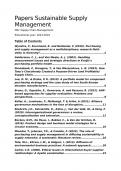Papers Sustainable Supply
Management
MSc Supply Chain Management
Educational year: 2023-2024
Table of Contents
Wynstra, F., Suurmond, R. and Nullmeier, F. (2019). Purchasing
and supply management as a multidisciplinary research field:
Unity in diversity?.....................................................................2
Gelderman, C. J., and Van Weele, A. J. (2003). Handling
measurement issues and strategic directions in Kraljic's
purchasing portfolio model........................................................3
Pannekoek, F., Breugem, T., & Van Wassenhove, L. N. (2023). How
Tony’s Chocolonely Created a Purpose-Driven (and Profitable)
Supply Chain............................................................................5
Lee, D. M., & Drake, P. R. (2010). A portfolio model for component
purchasing strategy and the case study of two South Korean
elevator manufacturers.............................................................6
Bruno, G., Esposito, E., Genovese, A. and Passaro, R. (2012). AHP-
based approaches for supplier evaluation: Problems and
perspectives.............................................................................8
Keller, A., Lumineau, F., Mellewigt, T. & Ariño, A (2021). Alliance
governance mechanisms in the face of disruption.....................11
Roehrich, J.K., Selviaridis, K., Kalra, J., Van der Valk, W., & Fang, F.
(2020). Interorganizational governance: a review,
conceptualisation and extension..............................................12
Bocken, N.M., De Pauw, I., Bakker, C., & Van der Grinten, B.
(2016). Product design and business model strategies for a
circular economy.....................................................................16
Miandar, T., Johnsen, T.E., & Caniato, F. (2023). The role of
purchasing and supply management in diffusing sustainability in
supply networks: A systematic literature review.......................18
Tate, W.L., Ellram, L.M., & Gölgeci, I. (2013). Diffusion of
environmental business practices: A network approach.............20
Carter, C.R. (2000). Ethical issues in international buyer-supplier
relationships: A dyadic examination.........................................23
,Reilly, T., Saini, A., & Skiba, J. (2020). Ethical Purchasing
Dissonance: Antecedents and Coping Behaviors........................25
Wynstra, F., Suurmond, R. and Nullmeier, F.
(2019). Purchasing and supply management
as a multidisciplinary research field: Unity in
diversity?
Introduction: The article presents a structured literature review of purchasing and supply
management (PSM) research across various disciplines. It focuses on topics and theories to identify
possible synergies across disciplines. The review is based on a census of 2522 PSM publications in 18
high-impact management journals from 1995 to 2014.
Findings: The analysis reveals that PSM publications grew more rapidly than the overall body of
research in the surveyed period. In the most recent period, one out of six articles (16%) dealt with
PSM research across the 18 journals. Operations management (OM) journals had the highest share
of PSM research, followed by marketing (MA) and strategy and organization (SO) journals. The
prevalence of PSM research increased in OM journals, while it decreased in MA and SO journals. The
article also provides additional data and analyses in the appendices, including information on the
origins of PSM publications and detailed prevalence rates of PSM research for individual journals and
Conclusion: The study conducted a structured literature review of purchasing and supply
management (PSM) research across various disciplines. The analysis was based on a census of 2,522
PSM publications in 18 high-impact management journals from 1995 to 2014. The study found that
the total number of PSM publications tripled in the most recent period compared to the first, with a
significant increase in the prevalence of PSM research in operations management (OM) journals.
However, more than half of the studies did not explicitly relate to any of the identified grand
theories, indicating room for improvement in the use of theory in PSM research. The study also
highlighted the need for future research to explore the development of PSM research on specific
topics over time and to include a wider range of journals
, Gelderman, C. J., and Van Weele, A. J.
(2003). Handling measurement issues and
strategic directions in Kraljic's purchasing
portfolio model.
The Kraljic Approach: The Kraljic approach is a purchasing portfolio model that has been widely used
since its introduction in 1983. It aims to help organizations make strategic decisions by categorizing
products based on two dimensions: profit impact and supply risk. The approach provides a
framework for analyzing and managing supplier relationships, with different strategies
recommended for each category.
Methodology: The methodology used in the case studies involved exploring advanced practices in
purchasing portfolio models. Three case studies were conducted, involving different companies and
levels of analysis. The objective was to identify and describe the measurement methods and
strategic approaches used by experienced purchasing professionals.
Measurement and Use: Measurement issues are a key concern in purchasing portfolio analysis. The
case studies revealed three different measurement methods: consensus method, one-by-one
method, and weighted factor score method. Each method has its own advantages and is used to
satisfy the needs and expectations of different users. The filling of the matrix is just the starting
point, and users need to reflect on the results and make manual adjustments if necessary.
Moving the Matrix: The Kraljic matrix allows for movements within its categories based on changing
buyer/seller relationships. The case studies identified different strategies for moving within the
matrix, such as reducing dependence on a supplier or seeking alternative suppliers. The framework





